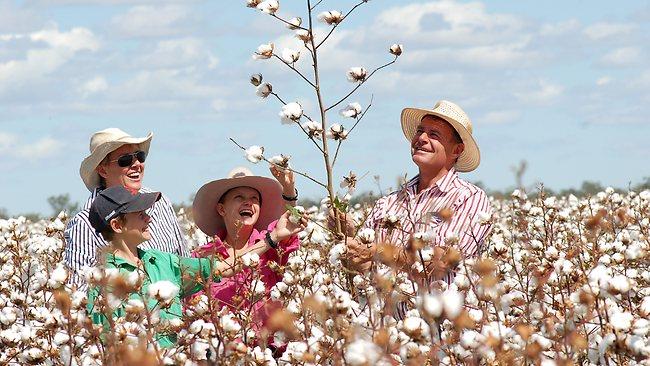Upbeat farmers cotton on to the boom
A SIMPLE motto saw farmer Andrew Parkes through the drought years: "A pessimist in agriculture is not going to get very far."

A SIMPLE motto saw farmer Andrew Parkes through the drought years, through sacking staff and selling equipment, and on to the largest, most valuable Australian cotton harvest ever seen: "A pessimist in agriculture is not going to get very far."
While pessimism may at times have seemed to wrack the industry -- in the midst of the dry when the total crop dropped to 60,000ha, compared with the 660,000ha it is today -- those who fought and clung on can enjoy the boom years now.
Cotton Australia, the industry's peak body, predicts growers will reap more than four million bales this season, worth $2.3 billion, or almost 10 per cent of Australia's total farm exports.
The previous record was set in 2000-01, with 3.6 million bales valued at about $1.8bn. That was the last year before the decade of drought that brought rural Australia to its knees.
A freak concurrence of high rainfall and high prices this season means growers can not only produce aplenty but enjoy top-dollar returns as well.
Mr Parkes can't believe his luck. "We're very happy with the harvest and we are exceptionally happy with the price," he said.
"It's nice after a number of years of struggle street."
Mr Parkes, a second-generation farmer from the northern NSW town of Moree, manages six farms that grow cotton through Customised Farm Management, which he co-owns. Three farms will turn in their first profit in several years.
"It's all on the back of cotton," he said.
Yet the year has not been all smiles. Heavy rain swamped Mr Parkes's winter barley crop, causing it to be downgraded, and 16ha of chickpeas were so badly damaged they were unfit to harvest.
"We're hopeful that we'll come close to making up for what would've been a loss from the winter harvest with this cotton crop," he said.
It's a story replicated on many other farms.
Thankfully, Adam Kay, the chief executive of Cotton Australia, said the outlook for the next few years at least was good.
"In central Queensland where the Fairbairn Dam is completely full, I think there's three years' worth of production there," he said. "In NSW, where the Burrendong Dam is at capacity, I would say that would give irrigators in the Murray Valley a couple of years production."
The added certainty allowed growers to capitalise on the boom, Mr Kay said.
"The Australian (cotton) market is very sophisticated," he said.
"Growers are able to forward-sell production up to three years ahead and lock in prices.
"Prices have risen to their highest level since the American Civil War."
The chief executive of Jernigan Commodities and an expert on the global cotton industry, Ed Jernigan, said the record prices were due in large part to the global food crisis of 2007-08.
"In the US, a lot of the cotton infrastructure that had been in place for 50 years or more was taken out as growers switched over permanently, mainly to soya," he said.
Even though US farmers knew cotton prices were on the up, the lost infrastructure meant fewer than expected could switch back.
"China went from being a small cotton importer to a massive cotton importer when their consumption rebounded after the global financial crisis," Mr Jernigan said.
"China has made a strategic move in which cotton is now no longer a strategic commodity; the concentration is now on the food."
He predicted China would remain a net cotton importer for the next few decades and said Australian growers had an implicit advantage thanks to the high quality and high yield of their product.
"The Australian cotton crop, regardless of its size, (is) in very high demand around the world all of the time," he said.
"If growers manage the risk appropriately, it could be lucrative for the next five to six years."
Mr Parkes is glad to see optimism flood back into Moree.
"There's a buzz back in town, there's activity, there are people on the street going to work and getting their businesses back together," he said.
Mr Parkes estimated that during the tough times the town shrunk by 10 to 20 per cent, and said the lack of work really hit people's confidence and self-esteem.
Not anymore.
"From the dealership right down to the coffee shop, there's just a vibrancy now that wasn't there 12 months ago," he said.
"I don't think it's that they've got money in their pockets.
"It's just that they can see there's a couple of good years ahead, and there's a future in agriculture that hasn't been there for a long time."



